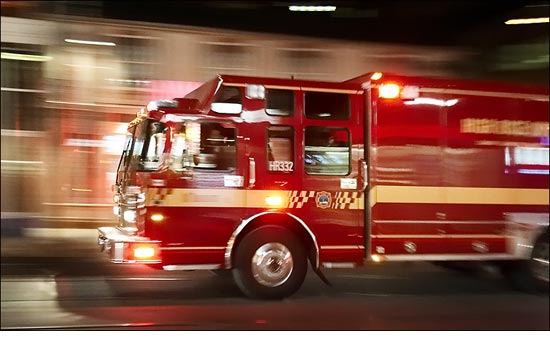At the intersection of safety and tragedy
December 2, 2010
On Feb. 12, 2008, a commercial fire broke out near Compton. A Los Angeles County fire truck rushed east along 135th Street toward the scene. Lights flashing, siren blaring, the truck was doing 35 mph when the light turned red at Figueroa Street. Firefighters thought everyone had stopped or pulled over. So, downshifting, the truck rolled through the intersection en route to the emergency.
They were mistaken. A catering truck had suddenly made a left turn into the fire truck’s path. In the back of the vehicle, court documents would later show, an $80-a-day cook named Antonia Roman had just finished warming tortillas for the next stop. Unrestrained by a seat belt, she was making her way back toward her passenger seat when the crash sent the catering truck careening onto its side.
Roman, a 43-year-old mother with a 6-year-old son still at home in Montebello, was thrown from the wreckage. When she regained consciousness, she was a paraplegic. The firefighter behind the wheel, meanwhile, would later discover that, in the course of a few years, the county’s policy for negotiating intersections on emergency calls had changed without his knowledge, requiring him to come to a full stop at the light, rather than to slow to a speed that was safe for the situation.
This week, the Board of Supervisors approved a $3.3 million settlement to Roman in the case.
The incident is significant, and not only because the injuries were so tragic and the settlement so substantial. It also highlights, once again, a complex, life-and-death question that public safety workers and policymakers deal with every day: What is the safest, best way for the driver of an emergency vehicle to negotiate an intersection when lives are in the balance?
In 2008, the last year for which statistics are available, there were 340 collisions involving emergency vehicles on Code 3 calls in California, 116 of them at intersections, according to the California Highway Patrol. The collision that crippled Roman was one of 36 involving emergency vehicles in Los Angeles County intersections that year.
Although the law is clear for civilian drivers—when an emergency vehicle approaches, you stop or pull over and yield the right-of-way—answers are not as definitive for those on the other side of the lights and sirens.
The California Vehicle Code exempts emergency vehicles en route to 911 calls—fire trucks, ambulances, police cars, etc.—from many rules of the road, including those involving red lights. The sole stipulation is that that the vehicle be driven at a speed that’s safe for the road conditions and “with due regard for the safety of all persons using the highway.”
Within those parameters, however, policies vary among agencies and jurisdictions when it comes to balancing the urgency of the call against the need for safety.
“The law says you have to clear the intersection—you can’t just blow through it,” says California Highway Patrol Executive Lt. Kevin Gordon. “You have to make sure it’s safe to proceed and that other motorists are aware of your presence. But there are variances in how best to implement that.”
The policy of the Los Angeles City Fire Department, for instance, is to “stop at all red lights and stop signs . . . and when safe, proceed through the intersection with caution.” The Pasadena Fire Department’s policy does not spell out whether a full stop is required when entering an intersection against a red light. However, the department’s emergency response procedures list “driving against traffic lights” as one of a series of conditions that require “reduced speed and extra caution.”
The county’s policy, meanwhile, has gone back and forth in its attempt to maximize safety, from a 2000 policy that instructed drivers to “slow to a speed which would allow observation of approaching vehicles and pedestrians” to the policy in force at the time of the collision, which told drivers to “stop at all signal controlled intersections that display a red light . . .”
Since then, the policy has again been updated, requiring that the driver simply apply the law with caution and “clear the intersection, lane by lane, until all traffic has yielded the right of way.”
An overview presented to the Board of Supervisors in connection with the Roman case suggests that those shifts may have been confusing. Listed among the factors that “gave rise to [the] accident” was a “failure to be aware of and adhere to the current Department driving policy” on the driver’s part, and a similar failure by his captain to make him aware of the policy.
“We’re trying to learn from what happened,” says Los Angeles County Fire Chief P. Michael Freeman. The challenge, he says, is in balancing the need for swift, potentially life-saving emergency response with the need to navigate traffic safely as public safety workers rush to deliver help.
Traffic safety is crucial, he says, but bringing a heavy truck to a full stop and then getting it up to full speed again takes time when every moment counts. What’s more, he says, stopping at an intersection may confuse other drivers about whether they should stop, go or look for flames around them.
Says the chief: “It’s a question of what’s safest for the public and what’s safest for the people on the other end of the 911 call we’re trying to get to.”
Posted 12/2/10













 405 bridge work causes a stink
405 bridge work causes a stink
